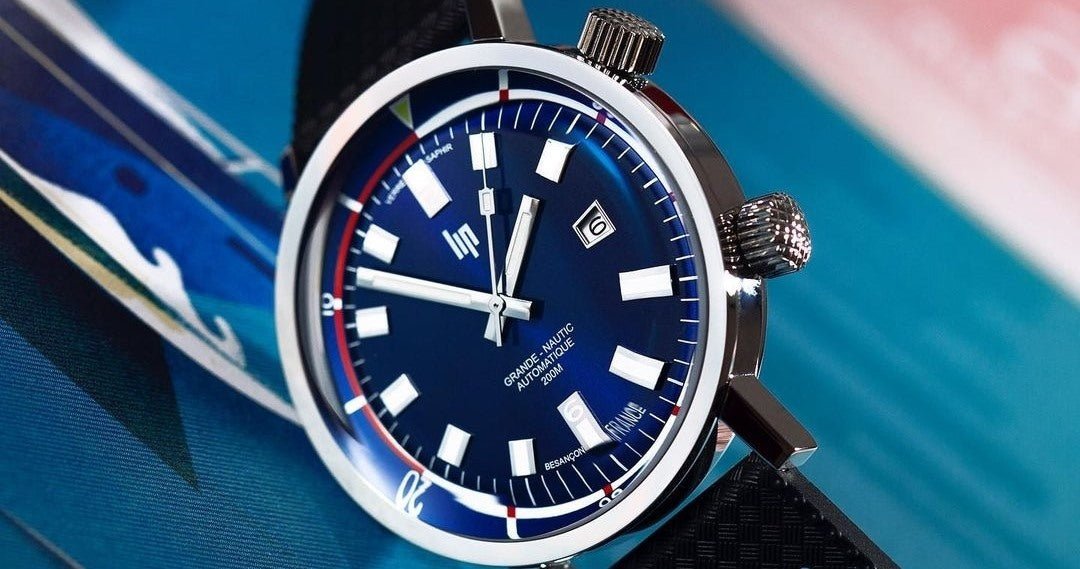
LIP: the story of a great French watch brand
Share
LIP is a French watch brand with a strong and tumultuous history. A flagship of French watchmaking from the end of the 19th century to the 1970s, known throughout the world, LIP experienced great difficult times causing multiple takeovers. Lip represents French know-how as well as the problems of industrialization and relocation. Today, LIP has regained superb momentum by reconnecting with its heritage.

Emmanuel Isaac Lipmann , son of a seller of watchmaking equipment in Alsace, founded a watchmaking workshop in 1867: Comptoir Lipmann in Besançon. Thanks to his entrepreneurial spirit, his desire for innovation and the support of his children (Ernest, Camille and Jenny), Emmanuel Lipmann very quickly developed this workshop in this city which would become the capital of French watchmaking.
In 1904, Ernest Lipmann, then in charge of technical development, developed thanks to Pierre and Marie Curie the first phosphorescent watch dials thanks to their discovery of radium. 
In 1908, the LIP brand was registered and the watches left the workshops bearing the brand logo for the first time. What followed was a distribution revolution for the time. A huge advertising campaign, with billboards and magazine publication, made the brand known at the national level.

After a somewhat chaotic school career, Fred Lipmann , son of Ernest Lipmann, entered the watchmaking school in Besançon. After his military service, a trip to the United States allowed Fred Lipmann to visit industrial assembly lines at Harley Davidson and Indian Motorcycle, as well as American watch manufacturers. In 1931, he joined the family business, took over the management of the company and upset traditions thanks to his visionary genius. Several great innovations then came out of the LIP factories.

In 1935, in full development of aeronautics, where the estimation of time was essential (the capacities of kerosene greatly limited flight times), LIP designed a watch that would equip the Croix du Sud (Latécoère) of Jean Mermoz with the Type 10 .
Produced between 1935 and the end of the 1950s, in the midst of the Art Deco period, the T18 was a worldwide success. A gold version will be offered by France to Sir Winston Churchill in 1948 in recognition of the services rendered by Great Britain during the Second World War. The T18 will then take "Churchill" as a nickname.

In 1952, under the direction of Fred Lip, Lip's research department worked on an entirely new concept of movement, not mechanical but electric. Several major constraints are resolved: miniaturize the batteries of the time, allow sufficient spring tension despite a low voltage. The oscillation of the spiral balance wheel is finally maintained by electromagnetism, which makes the " Electronic " the first electric watch on the market in 1958. Its name will be renamed " General De Gaulle " following the gift of a copy to him. this. It will even become the "watch of presidents" after another copy was offered to General Eisenhower by the French government.

At that time, LIP was at its peak, producing 300,000 watches per year thanks to the work of 1,500 employees.

In 1967, for the centenary of the family business, the Lip factory created a new kind of watch: the Nautic-Ski . This watch will be the first French diving watch to be able to reach 200m. Intended for extreme environments, great depths and great altitudes, it takes its name from the career of professional skier followed by the daughter of Fred Lip, member of the French alpine ski team. The model will be officially unveiled at the Olympic Games in Grenoble in 1968. This model will be worn by Eric Tabarly or Jacques-Yves Cousteau .

With the rise of design in the 70s, in a desire to remain at the forefront, LIP collaborates with several renowned designers, not necessarily linked to watchmaking. Thus, a first mechanical watch with digital display will leave the factories thanks to the vision of François Baschmakoff . Roger Tallon, Rudolg Meyer, Marc Held, Michel Boyer, Isabelle Hebey, Michel Kinn and Jean Dinh Van will successively bring their "leg" to the 1975 collection of ultra-design models which still impress today! 

